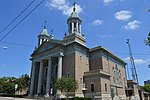Old St. Joseph's Cemetery

The Old St. Joseph's Cemetery is located at West Eight Street & Enright Avenue in the Price Hill neighborhood of Cincinnati, Ohio. The Cemetery was founded at West Eight Street & Enright Avenue, in 1843 by Rev. John Baptist Purcell, for both English & German speaking Catholics. The Irish section of St. Joseph Cemetery had reached its capacity after the cholera outbreak of 1849, the new cemetery was located two miles (3 km) west. The Germans remained and expanded the West Eight & Enright location. The first burials were made in January 1843, when a child Joseph Menke and an adult John Herman Dornkamp were laid to rest. Each of the German RC churches had a section in the old cemetery and many of the older monument's inscriptions contain only German. The main gate is located near West Eighth and Seton Avenues
Excerpt from the Wikipedia article Old St. Joseph's Cemetery (License: CC BY-SA 3.0, Authors, Images).Old St. Joseph's Cemetery
West 8th Street, Cincinnati
Geographical coordinates (GPS) Address Nearby Places Show on map
Geographical coordinates (GPS)
| Latitude | Longitude |
|---|---|
| N 39.103333333333 ° | E -84.577777777778 ° |
Address
West 8th Street
West 8th Street
45238 Cincinnati
Ohio, United States
Open on Google Maps









